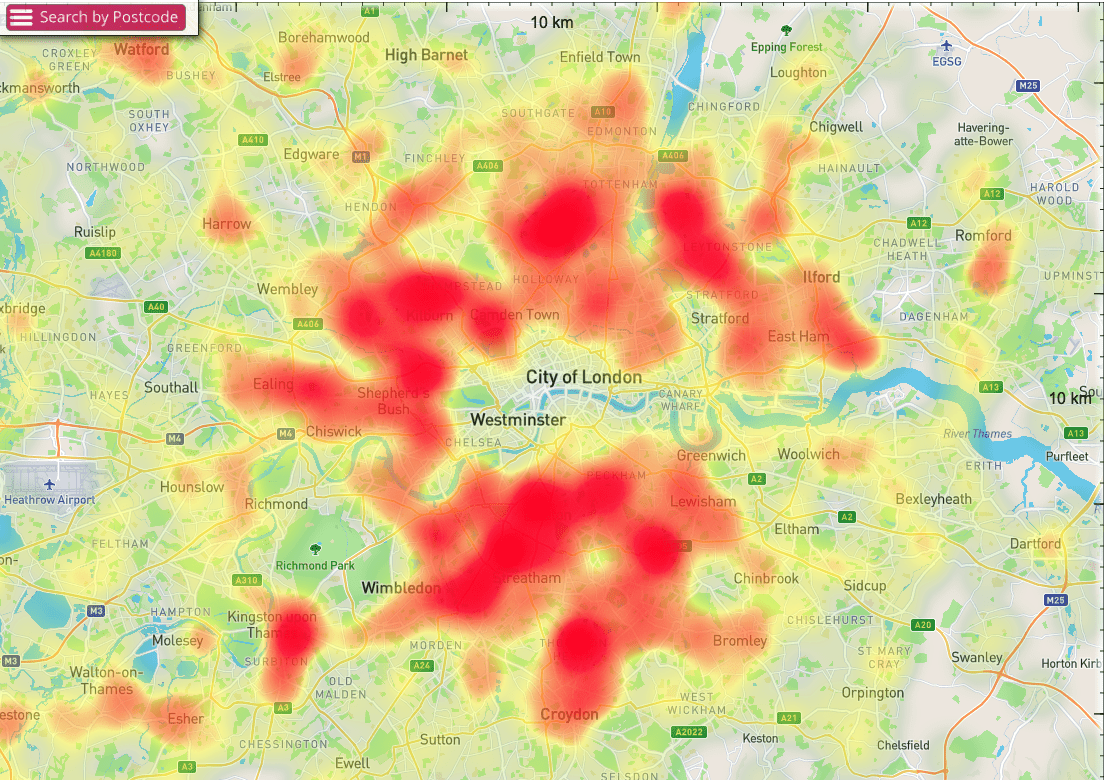A new heatmap has revealed the worst spots in London for Japanese knotweed.
With the growing season underway, invasive plant specialist Environet UK has looked to identify the places with the most amount of infestations in the capital.
Streatham and Brixton were revealed to be the worst two areas, with the former also one of the worst-affected locations in Great Britain.
Kilburn and Tottenham also ranked in the top five, alongside Leytonstone in East London.
| Location in London | Infestations within 4km radius |
| Streatham | 300 |
| Brixton | 294 |
| Kilburn | 273 |
| Tottenham | 219 |
| Leytonstone | 206 |
History of Japanese knotweed
Japanese knotweed first arrived in UK in 1850 in a box of plant specimens delivered to Kew Gardens. Favoured for its rapid growth and pretty heart-shaped leaves, it was quickly adopted by gardeners and horticulturalists who were oblivious to its invasive nature.
Knotweed hibernates over winter but in March or April it begins to grow, with red or purple spear-like shoots emerging from the ground which quickly grow into lush green shrubs with pink-flecked stems and bamboo-like canes.
Why is knotweed a problem for homeowners?
For homeowners, the plant can pose serious problems if left unchecked, with the potential to grow up through cracks in concrete, tarmac driveways, pathways, drains and cavity walls.
The roots can grow as deep as 3 metres and spread up to 7 metres horizontally. While serious damage to property is rare thanks to regulation which requires knotweed to be dealt with when a property is sold to a buyer using a mortgage or if it encroaches across a garden boundary, it commonly impacts use of the garden, causes legal disputes between neighbours and can impact a property’s value by around 5 per cent.
London heatmap

How to spot Japanese knotweed
· Asparagus-like spears emerge from the ground in early spring and begin to sprout pale green leaves with distinctive pink veins
· In May the plant starts to grow rapidly. The stems harden into bamboo-like structures and the leaves, which grow in a zigzag pattern up the stem, are lush, green and heart-shaped
· By mid-summer the plant grows at a rate of around 10cm per day, with mature plants forming dense stands two or three metres tall
· In August the plant blooms, with small clusters of creamy white flowers appearing on the upper leaf axials.
What to do if you think you have Japanese knotweed
· If you find a suspicious-looking plant and you’re not sure what it is, check out the identification guide on Environet’s website or use the free ID service by sending a photo to [email protected]
· Once knotweed is confirmed, commission a professional Japanese knotweed survey to find out the extent of the infestation, where it originated and the best way to tackle it
· Arrange professional treatment, usually herbicide or excavation, and always be sure to secure an insurance-backed guarantee for the work
· Sellers are legally obliged to tell any potential buyer if a property has been affected by knotweed, even if the infestation has been treated
· It’s not illegal to have knotweed on your land, but you will be liable if you allow it to spread to someone else’s property through inaction
· If you’re buying a property and you want to be sure it’s clear of knotweed, particularly if it’s located in or near a hotspot, arrange a detection dog survey.
Related: Help! Dad wants to give me two flats, will he get taxed?

